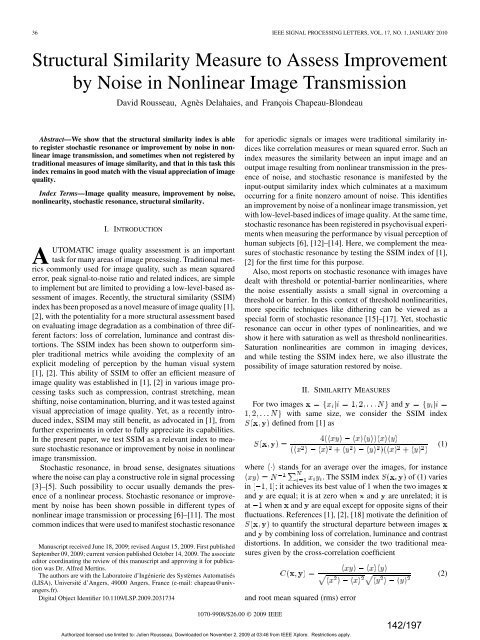a la physique de l'information - Lisa - Université d'Angers
a la physique de l'information - Lisa - Université d'Angers
a la physique de l'information - Lisa - Université d'Angers
Create successful ePaper yourself
Turn your PDF publications into a flip-book with our unique Google optimized e-Paper software.
36 IEEE SIGNAL PROCESSING LETTERS, VOL. 17, NO. 1, JANUARY 2010<br />
Structural Simi<strong>la</strong>rity Measure to Assess Improvement<br />
by Noise in Nonlinear Image Transmission<br />
David Rousseau, Agnès De<strong>la</strong>haies, and François Chapeau-Blon<strong>de</strong>au<br />
Abstract—We show that the structural simi<strong>la</strong>rity in<strong>de</strong>x is able<br />
to register stochastic resonance or improvement by noise in nonlinear<br />
image transmission, and sometimes when not registered by<br />
traditional measures of image simi<strong>la</strong>rity, and that in this task this<br />
in<strong>de</strong>x remains in good match with the visual appreciation of image<br />
quality.<br />
In<strong>de</strong>x Terms—Image quality measure, improvement by noise,<br />
nonlinearity, stochastic resonance, structural simi<strong>la</strong>rity.<br />
I. INTRODUCTION<br />
AUTOMATIC image quality assessment is an important<br />
task for many areas of image processing. Traditional metrics<br />
commonly used for image quality, such as mean squared<br />
error, peak signal-to-noise ratio and re<strong>la</strong>ted indices, are simple<br />
to implement but are limited to providing a low-level-based assessment<br />
of images. Recently, the structural simi<strong>la</strong>rity (SSIM)<br />
in<strong>de</strong>x has been proposed as a novel measure of image quality [1],<br />
[2], with the potentiality for a more structural assessment based<br />
on evaluating image <strong>de</strong>gradation as a combination of three different<br />
factors: loss of corre<strong>la</strong>tion, luminance and contrast distortions.<br />
The SSIM in<strong>de</strong>x has been shown to outperform simpler<br />
traditional metrics while avoiding the complexity of an<br />
explicit mo<strong>de</strong>ling of perception by the human visual system<br />
[1], [2]. This ability of SSIM to offer an efficient measure of<br />
image quality was established in [1], [2] in various image processing<br />
tasks such as compression, contrast stretching, mean<br />
shifting, noise contamination, blurring, and it was tested against<br />
visual appreciation of image quality. Yet, as a recently introduced<br />
in<strong>de</strong>x, SSIM may still benefit, as advocated in [1], from<br />
further experiments in or<strong>de</strong>r to fully appreciate its capabilities.<br />
In the present paper, we test SSIM as a relevant in<strong>de</strong>x to measure<br />
stochastic resonance or improvement by noise in nonlinear<br />
image transmission.<br />
Stochastic resonance, in broad sense, <strong>de</strong>signates situations<br />
where the noise can p<strong>la</strong>y a constructive role in signal processing<br />
[3]–[5]. Such possibility to occur usually <strong>de</strong>mands the presence<br />
of a nonlinear process. Stochastic resonance or improvement<br />
by noise has been shown possible in different types of<br />
nonlinear image transmission or processing [6]–[11]. The most<br />
common indices that were used to manifest stochastic resonance<br />
Manuscript received June 18, 2009; revised August 15, 2009. First published<br />
September 09, 2009; current version published October 14, 2009. The associate<br />
editor coordinating the review of this manuscript and approving it for publication<br />
was Dr. Alfred Mertins.<br />
The authors are with the Laboratoire d’Ingénierie <strong>de</strong>s Systèmes Automatisés<br />
(LISA), <strong>Université</strong> d’Angers, 49000 Angers, France (e-mail: chapeau@univangers.fr).<br />
Digital Object I<strong>de</strong>ntifier 10.1109/LSP.2009.2031734<br />
1070-9908/$26.00 © 2009 IEEE<br />
for aperiodic signals or images were traditional simi<strong>la</strong>rity indices<br />
like corre<strong>la</strong>tion measures or mean squared error. Such an<br />
in<strong>de</strong>x measures the simi<strong>la</strong>rity between an input image and an<br />
output image resulting from nonlinear transmission in the presence<br />
of noise, and stochastic resonance is manifested by the<br />
input-output simi<strong>la</strong>rity in<strong>de</strong>x which culminates at a maximum<br />
occurring for a finite nonzero amount of noise. This i<strong>de</strong>ntifies<br />
an improvement by noise of a nonlinear image transmission, yet<br />
with low-level-based indices of image quality. At the same time,<br />
stochastic resonance has been registered in psychovisual experiments<br />
when measuring the performance by visual perception of<br />
human subjects [6], [12]–[14]. Here, we complement the measures<br />
of stochastic resonance by testing the SSIM in<strong>de</strong>x of [1],<br />
[2] for the first time for this purpose.<br />
Also, most reports on stochastic resonance with images have<br />
<strong>de</strong>alt with threshold or potential-barrier nonlinearities, where<br />
the noise essentially assists a small signal in overcoming a<br />
threshold or barrier. In this context of threshold nonlinearities,<br />
more specific techniques like dithering can be viewed as a<br />
special form of stochastic resonance [15]–[17]. Yet, stochastic<br />
resonance can occur in other types of nonlinearities, and we<br />
show it here with saturation as well as threshold nonlinearities.<br />
Saturation nonlinearities are common in imaging <strong>de</strong>vices,<br />
and while testing the SSIM in<strong>de</strong>x here, we also illustrate the<br />
possibility of image saturation restored by noise.<br />
II. SIMILARITY MEASURES<br />
For two images and<br />
with same size, we consi<strong>de</strong>r the SSIM in<strong>de</strong>x<br />
<strong>de</strong>fined from [1] as<br />
where stands for an average over the images, for instance<br />
. The SSIM in<strong>de</strong>x of (1) varies<br />
in ; it achieves its best value of 1 when the two images<br />
and are equal; it is at zero when and are unre<strong>la</strong>ted; it is<br />
at when and are equal except for opposite signs of their<br />
fluctuations. References [1], [2], [18] motivate the <strong>de</strong>finition of<br />
to quantify the structural <strong>de</strong>parture between images<br />
and by combining loss of corre<strong>la</strong>tion, luminance and contrast<br />
distortions. In addition, we consi<strong>de</strong>r the two traditional measures<br />
given by the cross-corre<strong>la</strong>tion coefficient<br />
and root mean squared (rms) error<br />
Authorized licensed use limited to: Julien Rousseau. Downloa<strong>de</strong>d on November 2, 2009 at 03:46 from IEEE Xplore. Restrictions apply.<br />
142/197<br />
(1)<br />
(2)


